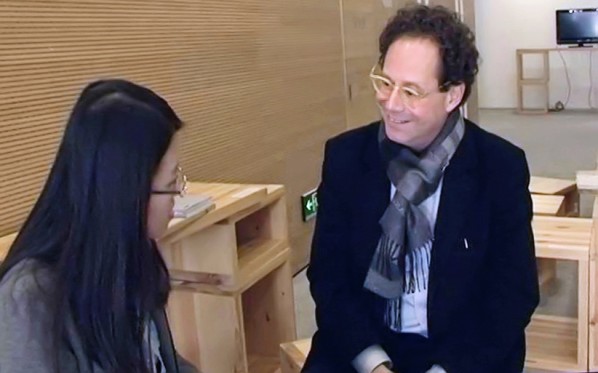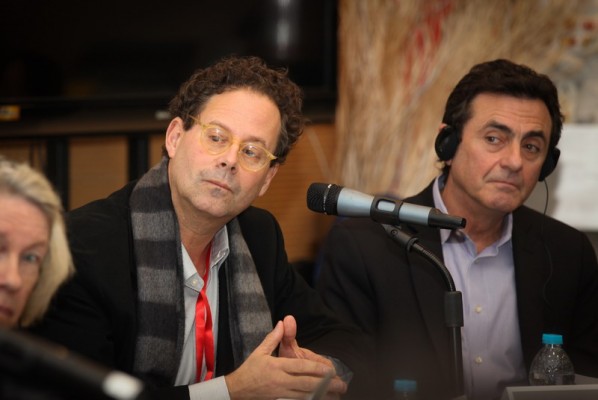
By Pan Gaojie
Introduction to the Interview: Adam D. Weinberg has been the Alice Pratt Brown Director of the Whitney Museum of American Art from 2003. During his tenure, he has overseen a range of major exhibitions, award winning educational programs, and dramatic growth in the permanent collection, as well as organized exhibitions with other internation museums. In 2010, the Whitney launched a capital campaign for the construction of a new Renzo Piano-designed building, scheduled to open in 2015.
From 1999 to 2003, Weinberg was the Director of the Addison Gallery of American Art at the Phillips Academy, Andover. At the Whitney, he was named Senior Curator in 1998 after holding the post of Curator of the Permanent Collection for five years. In 1991, Weinberg became the Artistic and program Director of the American Center in Paris. He joined the Whitney at the Equitable Center. Beginning in 1981, Weinberg served as Director of Educational and Assistant Curator at the Walker Art Center, Minneapolis.

Whitney Curator Adam D. Weinberg
Weinberg is the author of numerous catalogs and essays on contemporary and modern art. He has served as a board member of diverse organizations including the American Federation of Arts; Storm King Art Center; Williamstown Art Conservation Center; Tang Museum, Skidmore College; and the Colby College Museum of Art. He has been a grant panelist for numerous federal, state, city, and private foundations. He holds a BA from Brandeis University and an MA from the Visual Studies Workshop, the State University of New York at Buffalo.
C: CAFA ART INFO
A: Adam D. Weinberg
C: Does Whitney Museum have collaborations with universities at present?
A: Do we have collaborations with universities in United States?
C: Yes, and other places.
A: Well, we work with lots of students from different universities, we don't have a specific collaboration, we have our own program called Whitney Independent Study Program. Students, artists, critics and curators from all over the world come for one year to study in the independent study program, and they work together in intensive seminaries, and we usually have thirty people a year, and they are usually students that have graduated. They come from many countries, I'm not sure whether we have anybody from China but it would be great to have Chinese students. We also work with universities in other ways in the United State, but we have not done so abroad or not that I an remember, but it would be very nice to do so.
C: Is it an annual program?
A: Yes, annual program for 40 years now.
C: It's great.
A: Yes, it is called the Whitney Independent Study Program.
C: Is it on the official web site?
A: It's on the official web site, they take applications every year. For Chinese students, or interested students, so we are working towards more senior students.
C: I think this program is really beneficial to our students. And Do Whitney have any plans to expand this field?
A: Not specifically, collaborations, yes. But collaborations with university, are not necessarily the only plans. If there is a project that makes sense, but we don't have a plan to expand in a particular area.
C: Many curators mention the problem with the audience at the conference yesterday. Do you have any strategy on expanding the audience?
A: Well, Whitney Museum is building a new building in New York, which opens in 2015, and it is in a very popular location in New York, near a new park on an elevated pathway. I think our audience will expand dramatically because of the location and the new building, it will be three times the size of the current Whitney Museum. But our concern is that we are not too happy to see the audience grow too big, we want to make sure the quality of the experience is good. You don't want to go there if it is too crowded. You can't walk, you can't see. How do you maintain a good quality experience when you want be with the art in a quiet way and at the same time have a lot of people exposed to it.That is the challenge for the museum here and the challenge in the US as well. We talked a lot about this yesterday.

Adam D. Weinberg(the left) at Sino-American Culture and Art Forum “The Summit of Museum Directors”
C: I think a difference between Chinese and American Museums is that Americans have a membership system, and really emphasize it. How does the membership system work?
A: Well, the membership system consists of two things. One is to support, because museums in America are mostly privately funded, so the membership is probably the first and for most means of financial support for the organization. But secondarily, it's also an opportunity for people, because once they buy a membership, they can come many times to your museum and not have to pay each time they come. So it is financially beneficial to people to become members, because it can encourage them to come and also encourages us to get more deeply involved, because if you buy membership, usually you will come more than once, and most people just come once they don't usually buy memberships.
C: In your opinion, which museum has the best membership system right now?
A: Well, there are many different ones in the United States, I think the Whitney one is very good, because one of the things we have done is the same as in many museums, you get a membership, and it's only based on how much many you give, so you get more privileges if you give more money. Our membership system is not only according to the amount of money you gave but also based on your interest. Some people, if they interested in particular education, they can get more benefit from the education if they choose. They can also get more benefit because when they are interested in the social aspect, like the parties. And for some people, it's not so important to the members whether they support the education or they want to be with the artist some people just want to give money to due to philanthropy. So there are different benefits with our membership program, if you give money within that, not just the amount you give but how you participate in the museum is equally important
C: So there are different types and categories of membership.
A: Yes, different types, different categories, different flavors.
C: So what do you think is the biggest challenge that the museum will face in the next 20years?
A: Museums in general or just Whitney Museum?
C: Both?
A: OK. For the Whitney, I think as the audience expands, how do you maintain the quality of experience. The other thing is that in the Whitney museum and the new museum, we will offer more performing art and media art, and electronic, and what is the relationship with more traditional activities, museums presenting painting, sculpture, installation, and it should be talked about a little bit as to how the model of the internet takes you all over the place, so the need to come to the place is different from when you didn’t have the media that reaches every corner, so how do you connect the ideas of how the internet changes the experience but also the necessity for being in the museum to have the first experience of art. So we are concerned with this. That's the big challenge. And then of course, the big challenge is financial in the United States because it’s always private funded ,so it's dangerous with the United States system as you spend so much time looking for money so you don’t have enough time to think about what you are doing.
C: As you mentioned the new media art. I am interested in curating a new media art exhibition, it’s really different from curating sculptures or other traditional arts…
A: Absolutely. We don’t need a museum because you don’t have to be there, you can be at home. But museums, historically are based on having a connection with the original art work, and the idea of the original art work is destroyed by new media as you don’t have to be in the place. So how do you bring those two kinds of experiences together in a museum context, that’s one of our challenges? People don’t need to come to the museum to look at the computer terminal or on their laptop, you can do it at home and you can eat food and drink, you don’t have to be there. But people want to come together in museums, too. So how do you make the sense of an experience for people that want to be together and like looking at the original objects but also bring together the electronic community. That’s the challenge.
C: Speaking of the authority of the museum, do you think museums should accept the avant-garde art,or the recognized masterpiece?
A: For the Whitney it’s always about embracing the art at the present moment. The Whitney has never waited for history to make a stance. The Whitney is the artists’ museum, it’s a place working with artists, and they worked in the museum from the very beginning. And they are involved so for artists it’s always about the understanding the part of the present. And also to look at it as a part of history. It’s not saying we are only interested in the contemporary, but we need to look at the present moment and not just look at the past. That's the role of the Whitney Museum.
C: So do you use criteria to decide which contemporary artist is qualified?
A: Yes. We have curators that are involved in discussion and research. There are not set criteria. But there are criteria on how to maintain the quality of the work. The idea of what is the artist’s work we think will really last, is the artist just making good work, but does the work change the paradigm on the way people think. There are many artists that are good artists. But how many artists change the way you think about the world in a really radical way. That's not so common.
C: Does the Whitney Museum only focus on American contemporary art?
A: Yes. We only collect American art, and artists who are working in the United States. So if you work in the United States, you are an American artist. So it could be any artist working in the United States.
C: So Xu Bing used to be an American artist?
A: Exactly, and also we can show the works of other artists, but we are more interested in the relationship of American art to art of the world. So it's not just American art by itself, but American art is connected with other places. But it's not art from the other parts of the world by itself either; it has to be about the connection.
Courtesy of CAFA ART INFO.




























